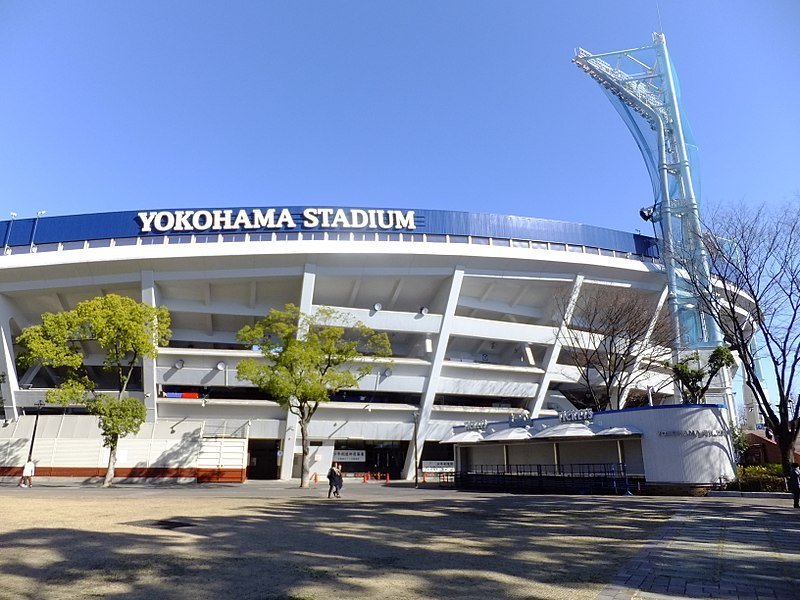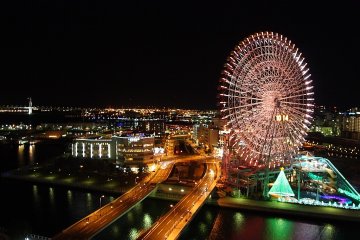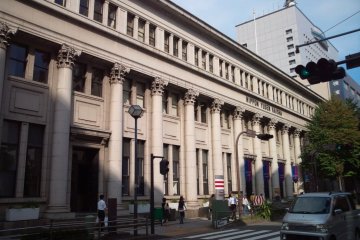
Yokohama Stadium
Yokohama Stadium is located in Naka-ku, Yokohama, and is a multi-purpose stadium. These are quite rare these days. Yokohama Stadium opened in 1978 and can seat over 30,000 people. Today the stadium...

Yokohama Park is the second oldest park in Yokohama after Yamate Park and was opened to the public in 1897. With the construction of Yokohama Stadium, the dilapidated facilities of the park were renovated and a Japanese garden-style pond and creek, a fountain and a river were renovated Multipurpose space expanded.
Around 140,000 tulips of around 70 varieties will be planted in Yokohama Park in November. The flowering time varies depending on the variety, but depending on the weather, the tulips are usually in full bloom from the beginning to the end of April. The park is a particularly popular travel destination at this time.
3-minute walk from Nihon Odori Station (Minatomirai Line)

Yokohama Stadium is located in Naka-ku, Yokohama, and is a multi-purpose stadium. These are quite rare these days. Yokohama Stadium opened in 1978 and can seat over 30,000 people. Today the stadium...

[photo] [photo] ワシントンホテル(華盛頓飯店)在日本是連鎖飯店, 在首都圈(東京及周邊)就設有12家飯店, 我今年跟家人去賞櫻回程班機較早, 所以也住在関西エアポートワシントンホテル(關西機場華盛頓飯店), 整體而言屬於整齊乾淨的商務型旅館, 現在介紹的是横浜桜木町ワシントンホテル(橫濱櫻木町華盛頓飯店)。 [photo] 桜木町駅出來後徒步只要1分鐘就能到達, 算是交通相當方便的旅館, 而它的外觀辨識度相當高, 建築物從側面看起來似乎有些弧度。 [photo] [photo] 它的入口其實不明顯, 加上飯店大廳並沒有在一樓, 所以要找的時候請記得認一下飯店標誌, 或是從桜木町駅出來後走上人行天橋進來也能到飯店大廳, 比較有趣的是在飯店大廳就有24小時營業的全家便利商店, 晚上真是超方便的!! [photo] [photo] [photo] [photo] 打開房間,大小其實跟一般商務旅館差別不大, 要記得把房卡插入插槽後房內才會通電, 而空調開關就在插槽旁邊, 門旁就有熱水壺、茶具及冰箱。 [photo] [photo] [photo] 電視機旁邊就是書桌, 由於書桌上就放著一盞檯燈,亮度很充足, 不過桌上東西有點多,電話、遙控、便條紙等物品, 感覺空間就變小了。 [photo] [photo] 床躺起來很軟,被子不會很厚但很保暖, 晚上雖然空調開得有點大,但還是一覺到天亮, 床頭放了有趣的東西,那是「攜帶用充電器」, 用來幫手機充電,能支援的手機種類不少,超有趣! [photo] [photo] 浴室跟廁所的空間不大, 跟一般商務旅館相去不遠, 使用的洗髮精及沐浴乳都是TSUBAKI的。 [photo] [photo] 雖然橫濱櫻木町華盛頓飯店是商務旅館, 不過由於它的地點不錯, 所以面海的窗戶也有很不錯的風景, 加上每晚平均在NT2300~2600算是CP值不錯的住宿選擇。 横浜桜木町ワシントンホテル 横浜市中区桜木町1-101-1 http://washington-hotels.jp 更多的關東地區住宿 橫濱地區飯店住宿的比價網站

[photo] [photo] 對我而言,出國遊玩跟享受美食是劃上等號, 所以在機票跟住宿的預算總是希望能少則少, 不過既然都去了,也不要太苛刻自己, 每次行程住一兩家高級飯店奢侈一下也不為過, 就如之前所說,想住好飯店只要提早訂房,通常都有不錯的優惠, 連Pan Pacific Yokohama Bay Hotel Tokyu(泛太平洋橫濱灣飯店)也不例外, 像這次入住的金額才日幣一萬出頭,房型是面向摩天輪且有陽台的房間, 雖然不含早餐,但已經非常超值! [photo] [photo] [photo] 泛太平洋橫濱灣飯店跟橫濱皇家花園飯店一樣都在橫濱MM21地區, 無論飯店硬體或人員服務都是相當有水準的飯店, 可惜這次來的時間太晚,沒有拍到整個飯店的外觀, 大廳看起來相當豪華,不過整個空間感覺有些複雜, 門禁管制採用的是房卡而不是鑰匙,比起橫濱皇家花園的鑰匙差異好大。 [photo] [photo] [photo] 使用房卡打開門後,可以直接看到整個房間, 房間蠻大的,就算打開兩個大行李箱也還有很充裕的空間, 而且能稍微看到窗外的夜景, 床躺起來也相當軟及舒服, 相信躺在上面能有很不錯的睡眠品質。 [photo] [photo] [photo] 兩張床的中間放著一張床頭櫃, 上面放著電話、面紙、鬧鐘及電視搖控器, 而床的對面就是電視機,旁邊桌上還有熱水壺可使用。 [photo] [photo] [photo] 衣櫃的一邊裡吊著兩件浴袍,地上有拖鞋, 另外一邊由上到下有茶具櫃、保險箱及櫃子, 把抽屜拉開後看到放著兩件睡衣在裡面, 讓有需要的住客可以使用。 [photo] [photo] [photo] [photo] [photo] [photo] [photo] 浴廁的空間很大,在住過的飯店裡算很大, 馬桶跟淋浴的地方有各自的空間, 而浴缸跟梳妝台不小,備品方面也相當齊全, 還貼心了準備棉花棒跟髮圈在裡面, 吹風機也直接放在梳妝台上。 [photo] [photo] [photo] [photo] [photo] 最後是這次住宿的重點-房間陽台上的景色, 走出陽台前要記得要把落地窗兩邊的卡榫打開才能出去, 在陽台就能看到對面的摩天輪,景色真的很不錯, 往右邊拍可以拍到摩天輪跟一小部份的街景, 往左邊拍可以拍到外觀呈船帆狀的橫濱洲際飯店, 反正住在這邊,在摩天輪關燈前想怎麼拍就怎麼拍啦! [photo] [photo] [photo] [photo] 隔天早上因為要準備出發前往成田機場搭機返台, 所以天還沒亮就起床在收拾東西, 不過也因此看到天色微亮的漂亮景色, 真的是比夜景還要有看頭啊! 如果住在這裡,不妨早起拍完照後再回去睡回籠覺吧! Pan Pacific Yokohama Bay Hotel Tokyu 泛太平洋橫濱灣飯店 横浜市西区みなとみらい2-3-7 http://ybht.co.jp/ 更多的關東地區住宿

Yokohama Chinatown, also known as Yokohama Chukagai, is Japan’s largest Chinatown. An enclave of Chinese shops and restaurants has stood in this section of Yokohama since the port city was opened to international trade in 1859. The entrance to Chinatown is marked by four intricate and colorful gates, which represent the four directions in Chinese tradition. Each gate is associated with a different mythological animal an additional five gates stand within the neighborhood’s boundaries. More impressive architecture can be found at the Kanteibyo temple (also known as the Guan Gong Temple), which is dedicated to the Chinese god of successful business and prosperity. Built in 1873 by the neighborhood’s residents, it remains popular among the faithful and also welcomes visitors with its serene evening lantern displays. Nearby Masobyo Temple is newer and smaller, but this Taoist temple still impresses with its decorative touches. Chinatown is noted for its cuisine, from humble street stalls to gourmet feasts. Pork or mustard green steamed buns, egg tarts and goma-dango (sesame seed dumplings) all make for popular pick-me-up streets to grab on the go. In the many eateries that line the neighborhood streets, it’s possible to dine on any number of authentic Chinese dishes – spicy mapo tofu, duck, and dozens of dim sum options are just a few of the popular menu items on offer. Several stores in the area offer a unique shopping experience not often found in other Japanese cities. Pick out the perfect good luck charm or try your luck at a fortune teller. Browse the selection of one-of-a-kind “qipao”, a type of traditional Chinese dress. Or, stock your cabinet with a range of Chinese teas. Yokohama Chukagai sees its greatest influx of visitors every winter during the fifteen-day-long Chinese New Year festivities. The neighborhood is justifiably famous for its lavish celebrations, with lion dances, parades and numerous other activities. The streets are often decked out in lanterns and paper dragons; night visits are extremely atmospheric during this season.

Kanteibyo Temple (関帝廟) is a spiritual landmark in Yokohama’s Chinatown. It shines like a beacon of faith with its vibrant red exterior and intricate detailing. Dragon statues stand above the entrance with poised bodies and open mouths, fiercely guarding the temple. The interior is decorated ornately with gold designs, wordlessly speaking of the temple’s significance. In the center sits a statue of Guan Yu, a famous military general turned deity who is immortalized in the historical Chinese novel, Romance of the Three Kingdoms. Worshippers pray to Guan Yu for business and financial prosperity. History Founded in 1862, Kanteibyo was allegedly created when a Chinese migrant brought a statue of Guan Yu to Japan. The temple started humbly as a small shrine but expanded over the years thanks to donations from devout worshippers. Kanteibyo’s history was a turbulent one, as it stood witness to numerous calamities. In 1923, the temple was destroyed by an earthquake; years later it was damaged in 1945 during World War II air raids; and in 1986, it burned down due to an unsolved fire incident. After each destructive event, the town united to rebuild the temple, reflecting the residents’ deep sense of community and connection with each other and the temple. Today Kanteibyo has become entrenched in Chinatown’s legacy and is a frequented site by residents and tourists alike for prayer and admiration. The temple is dedicated to seven deities, all of which--except the Jade Emperor who is symbolized by the ceiling--are represented by lavishly adorned statues. These deities include the Jade Emperor, Guan Yu, Di Mu Niang Niang, Zhou Cang, Guan Ping, Guan Yin, and Fu De Zheng Shen. Centered in the temple is Guan Yu’s statue, which is red-faced, long bearded, and cloaked in brightly-colored attire. The most common way of praying involves the use of incense sticks. While fire is prohibited in the main shrine, worshippers can light the incense sticks outside and place them in five burners corresponding to the shrine’s deities. After lighting the incense, practicers enter the main building and pray to the deities in a specific order. Temple assistants can also help people tell their fortunes with the use of divination moon blocks. The temple holds celebratory events throughout the year with the most popular ones being on New Year, Lunar New Year, and Guan Yu’s birthday. These spectacles are filled with traditional Chinese performances such as lion and dragon dances.

The NYK Maritime Museum is a museum in Naka-ku, Yokohama, Kanagawa Prefecture, Japan, dedicated to the maritime history of Japan and of the museum's operator, shipping company Nippon Yūsen Kabushiki Kaisha. It was opened in 1993. [Wikipedia]